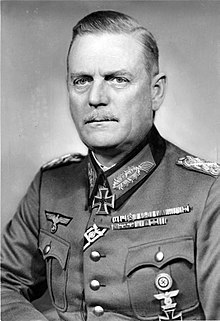
Back Wilhelm Keitel Afrikaans فيلهلم كايتل Arabic فيلهلم كايتل ARZ Vilhelm Keytel Azerbaijani Вільгельм Кейтэль Byelorussian Вилхелм Кайтел Bulgarian Wilhelm Keitel Breton Wilhelm Keitel Catalan Wilhelm Keitel Czech Wilhelm Keitel Danish
Wilhelm Bodewin Johann Gustav Keitel (German pronunciation: [ˈvɪlhɛlm ˈkaɪtl̩]; 22 September 1882 – 16 October 1946) was a German field marshal who held office as chief of the Oberkommando der Wehrmacht (OKW), the high command of Nazi Germany's armed forces, during World War II. He signed a number of criminal orders and directives that led to numerous war crimes.
Keitel's rise to the Wehrmacht high command began with his appointment as the head of the Armed Forces Office at the Reich Ministry of War in 1935. Having taken command of the Wehrmacht in 1938, Adolf Hitler replaced the ministry with the OKW and Keitel became its chief. He was reviled among his military colleagues as Hitler's habitual "yes-man".
After the war, Keitel was indicted by the International Military Tribunal in Nuremberg as one of the "major war criminals". He was found guilty on all counts of the indictment: crimes against humanity, crimes against peace, criminal conspiracy, and war crimes. He was sentenced to death and executed by hanging in 1946.[1]
- ^ "The Execution of Nazi War Criminals". famous-trials.com. Retrieved 7 October 2021.
